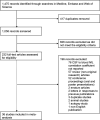Correlation between CSF and blood neurofilament light chain protein: a systematic review and meta-analysis
- PMID: 34223154
- PMCID: PMC8211066
- DOI: 10.1136/bmjno-2021-000143
Correlation between CSF and blood neurofilament light chain protein: a systematic review and meta-analysis
Abstract
Objective: To assess the overall pooled correlation coefficient estimate between cerebrospinal fluid (CSF) and blood neurofilament light (NfL) protein.
Methods: We searched Medline, Embase and Web of Science for published articles, from their inception to 9 July 2019, according to Preferred Reporting Items for Systematic Reviews and Meta-analyses guidelines. Studies reporting the correlation between CSF and blood NfL in humans were included. We conducted a random-effects meta-analysis to calculate the overall pooled correlation coefficient estimate, accounting for correlation technique and assay used. Heterogeneity was assessed using the I2 statistic test. In sensitivity analyses, we calculated the pooled correlation coefficient estimate according to blood NfL assay: single-molecule array digital immunoassay (Simoa), electrochemiluminescence (ECL) assay or ELISA.
Results: Data were extracted from 36 articles, including 3961 paired CSF and blood NfL samples. Overall, 26/36 studies measured blood NfL using Simoa, 8/36 ECL, 1/36 ELISA and 1 study reported all three assay results. The overall meta-analysis demonstrated that the pooled correlation coefficient estimate for CSF and blood NfL was r=0.72. Heterogeneity was significant: I2=83%, p<0.01. In sensitivity analyses, the pooled correlation coefficient was similar for studies measuring blood NfL using Simoa and ECL (r=0.69 and r=0.68, respectively) but weaker for ELISA (r=0.35).
Conclusion: Moderate correlations are demonstrated between CSF and blood NfL, especially when blood NfL was measured using Simoa and ECL. Given its high analytical sensitivity, Simoa is the preferred assay for measuring NfL, especially at low or physiological concentrations, and this meta-analysis supports its use as the current most advanced surrogate measure of CSF NfL.
Prospero registration number: CRD42019140469.
Keywords: CSF; CSF dynamics; clinical neurology; neurobiology; systematic reviews.
© Author(s) (or their employer(s)) 2021. Re-use permitted under CC BY-NC. No commercial re-use. See rights and permissions. Published by BMJ.
Conflict of interest statement
Competing interests: JA has received financial support to attend scientific conferences from MSD and Gilead Sciences. JU has received honoraria for preparation of educational materials and has served on an advisory board for Gilead Sciences. PE has received grants from the Medical Research Council, Alzheimer’s Research UK, Alzheimer’s Drug Discovery Foundation, Alzheimer’s Association, Alzheimer’s Society, Novo Nordisk®, Life Molecular Imaging, GE Healthcare, Eli Lilly and Company, Novartis International AG and NIHR Imperial Biomedical Research Centre (BRC). PE was also a consultant to Pfizer, is now a consultant to Novo Nordisk, and serves on the advisory board for Novo Nordisk. PE has received consultancy and speaker fees from Piramal Life Sciences, Pfizer and Novo Nordisk. AW has received honoraria or research grants on behalf of Imperial College London or been a consultant or investigator in clinical trials sponsored by Bristol-Myers Squibb, Gilead Sciences, GlaxoSmithKline, Janssen-Cilag, Roche and ViiV Healthcare. HZ has served at scientific advisory boards for Denali, Roche Diagnostics, Wave, Samumed and CogRx, has given lectures in symposia sponsored by Fujirebio, Alzecure and Biogen, and is a co-founder of Brain Biomarker Solutions in Gothenburg AB, a GU Ventures-based platform company at the University of Gothenburg (outside submitted work). SF received funding and research grants from the National Institutes of Health (NIH), Bill & Melinda Gates Foundation (BMGF) and Medical Research Council (MRC).
Figures




References
Publication types
Grants and funding
LinkOut - more resources
Full Text Sources
